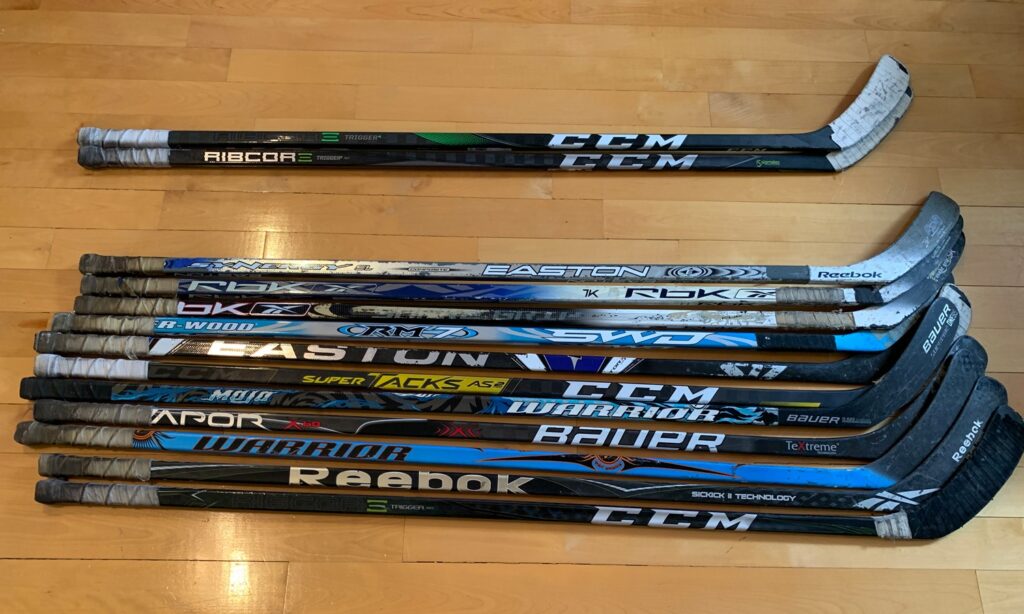Ever walk into the hockey stick section of a sporting goods store? You’re overwhelmed with the choices of sticks.
When you ask the employee for assistance, they might ask you questions related to your preference on stick flex, brand, stick weight, blade curvature, lie, kickpoint, price range and so on.
The process for choosing your stick shouldn’t be this complicated. The various brands introduced these selling point features to differentiate from their competitors.
Let me help break the selection process for you in 4 steps, with the first step being the main determining factor:
Select your stick in 4 STEPS:
- 1What are you looking most for in your shot - Power, Quick Release or All-around performance?
- 2Which blade curve is most suitable for your type of play?
- 3Which stick flex is ideal for your size?
- 4How much are you willing to spend?
That’s it!
In fact, if they don’t have the blade curve available for my preferred stick model, I’d walk away.
I still have nightmares of not being able to take a slap shot with a heel curve - just couldn’t do it.
Back then, the stick cost me $30. There’s no way I’m dishing out $300 for a premium composite, lightweight stick and settling with the same result.
For blade options, you can refer to the curve charts here. Since I'm big on CCM sticks, my preferred curves are P40 (Mackinnon) and P29 (Crosby).

Scroll to the CCM chart to find the equivalent in other brands.
From my experience, those two curves allow for effortless stick handling, toe dragging and good puck control for passing and shooting.
When it comes to stick flex, I can toggle between a 75 and 85 because of my weight - I’m 160lbs. To figure out the ideal stick flex, divide your weight (in lbs) by 2 and choose the flex closest to that value.
For example 160lbs / 2 = 80. Stick flex options are 75 and 85.
Note: Some manufacturers use different flex options such as 77, 87 etc. Always default to the nearest value and figure out if you want more or less flex in your stick for the next time.
Keep in mind that you'll definitely feel the difference in “stiffness” between flexes and will need to adapt for shot control.
In the end, try experimenting with different flexes, blade curves and kick points until you find that sweet spot.
Below, I’ve divided all the sticks in the categories just mentioned: Power, Quick Release or All-around performance.
Each brand uses a COLLECTION name to represent the category. For example, the CCM Ribcor, Bauer Vapor and Warrior Covert represent the Quick Release Shot (Low Kick) category.
Furthermore, I've separated them by MODEL type which directly reflects the stick weight and price. I do a side-by-side comparison for the models in each weight class.
That way, if you’re not satisfied with the model you chose the last time around, you can return to these comparative charts. From there, it's easier to decide in trying another stick from the same class or make the leap to a lighter stick.
Only composite sticks were used for comparison (i.e wood sticks were left out).
And since we are doing head-to-head comparison for various brands based on kick points, let me start by quickly explaining the term.
Kick Point Explained and Options
The kick point is defined as the softest point or area of the hockey shaft. As a player releases a shot - whether it's a wrist, slap or snap shot - the kick point is the first point where the stick will snap back into place. There is an inverse relationship between shot quickness and power - that is, the quicker the release, the weaker the shot power.
Below, I break down the various areas at which the kick point can be located along the shaft and it's function.
MID KICK POINT (POWER):
If you are looking for a stick that delivers the most power on a slap shot or one-timer, you need a stick with a Mid Kick Point. The softest point is higher along the shaft.
LOW KICK POINT (QUICK RELEASE):
Sticks that allow for a quick release wrist shot or snap shot have a Low Kick Point. The soft point of the shaft is closest to the stick blade.
HYBRID KICK POINT (ALL-AROUND):
If you’re looking for a stick that doesn’t compromise much on power, and still allows for a quick release, the solution is a Mid-Low Kick Point. The soft point of the shaft is found at the lower end of the stick, but still higher above that for the Quick Release.
Based on my research, I was able to track down six different hockey stick brands accounting for 50 different models.
The tables below will simplify your search options once you've determined which kick point best serves your game and how much you're willing to spend.
1. Mid Kick (POWER) - Best for Slapshots
| Brand/Collection | CCM TACKS | WARRIOR NOVIUM | SHERWOOD CODE | TRUE CATALYST | BAUER NEXUS | BAUER (Limited Edition) |
|---|---|---|---|---|---|---|
| Models | AS-VI Pro AS-VI AS-570 | Super Novium | TMP Pro Grip TMP1 Grip | 9X3 7X3 5X3 3X3 | Sync E5 Pro E4 E3 | Proto R |
| Weight (@60 inches) | 395g 405g 460g | 330g | 387g 405g | 350g 375g 420g 445g | 365g 390g 425g 450g | 345g |
| Flex Range (not all models) | 70, 75, 80, 85 | 65, 75, 85 | 65, 75, 85, 95 | 65, 75, 85, 95 | 70, 77, 87 | 70, 77, 87 |
| Price Range (USD) | $139.99-339.99 | $359.99 | $179.99-259.99 | $129.99-339.99 | $139.99-339.99 | $359.99 |
2. Low Kick (QUICK RELEASE) - Best for Wrist shots & Snapshots
| Brand/Collection | CCM RIBCOR | WARRIOR COVERT | SHERWOOD REKKER | TRUE HZRDUS X | BAUER VAPOR |
|---|---|---|---|---|---|
| Models | Trigger 8 Pro Trigger 8 86K | QR5 Pro QR5 20 Grip QR5 30 Grip QR5 50 Grip | Legend Pro | PX Grip 9X Grip 7X Grip 3X Grip | AG5NT Hyperlite 2 X5 Pro X4 X3 |
| Weight (@60 inches) | 380g 435g 460g | 395g 425g 435g 490g | 390g | 345g 375g 390g 445g | 335g 360g 390g 425g 450g |
| Flex Range (not all models) | 70, 75, 80, 85, 95 | 65, 75, 85, 100 | 75, 85 | 65, 75, 85, 95 | 70, 77, 87 |
| Price Range (USD) | $129.99-349.99 | $69.99-339.99 | $279.99 | $139.99-359.99 | $129.99-359.99 |
3. Hybrid Kick (ALL-AROUND)
| Brand/Collection | CCM JETSPEED | WARRIOR ALPHA |
|---|---|---|
| Models | FT6 Pro FT6 FT690 FT670 FT660 | LX2 Pro |
| Weight (@60 inches) | 365g 415g 425g 450g 485g | 375g |
| Flex Range (not all models) | 70, 75, 80, 85 | 75, 85 |
| Price Range (USD) | $79.99-349.99 | $349.99 |
Final Thoughts
Based on my research and own experience, the default choice for kick point is the Low (Quick Release) option.
If you've reviewed the charts above, Low Kick Point sticks are the most abundant compared to the other two. They make up 23 of the 50 sticks.
This comes as no surprise because players tend to shoot more wrist shots than any other shot types. In fact, I've done an analysis of shots administered on net from different areas of the ice. See my blog post here about How are Most NHL Goals Scored.
If you want a personal assessment on how to choose your kick point, consider the following. If you break your stick often off a wrist shot or snap shot, consider moving to the mid-low kick point (all-around).
If you're a stay-at-home defenseman, you can even move to the mid kick point (Power) since you'll want the most out of a shot from far out.
Your height and weight will also play a significant factor. So given that I'm 5'7" and 160 lbs, there is no way that I can assess what works best for someone much bigger than me.
In the end, you'll know which stick works out best for you. I've charted the kick points so that shopping for a hockey stick won't be like choosing a bottle of wine.






